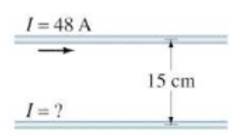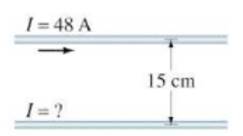
Concept explainers
(a)
The magnitude and direction of the current in the lower wire.
(a)
Answer to Problem 42P
The current in the lower wire is
Explanation of Solution
Given:
The given figure is shown below.

Current carried by upper horizontal wire is
Formula used:
The magnetic force is given by the formula
Calculation:
Using the right-hand rule, the magnetic force exerted on the lower wire is in an upwards direction. Now, since every force must be balanced. Thus, the magnetic force exerted upwards must be balanced by the gravitational force experienced downwards. Considering the length of the lower copper wire as
Conclusion:
Thus, for the magnetic force to be exerted upwards, the current must be in the right direction and the magnitude of the current in the lower wire is
(b)
To identify: Whether the lower wire in stable equilibrium.
(b)
Answer to Problem 42P
The lower wire is not in a stable equilibrium.
Explanation of Solution
Given:
The given figure is shown below.

Current carried by upper horizontal wire is
Formula used:
The magnetic force is given by the formula
Calculation:
To maintain stable equilibrium, all the forces exerted on any object must be balanced by the counter forces exerted by it.
Here, the magnetic force exerted on the copper wire is balanced by the gravitational force downwards. If wire moves a little bit farther from the top wire then the magnetic force weakens and the gravitational force supersedes. Thus, it will keep moving downwards, and farther it goes away from the top wire. Hence, the copper wire will not be in stable equilibrium.
Conclusion:
The lower Copper wire is not in a stable equilibrium.
(c)
The magnitude and direction of the current in the upper wire.
To identify: Whether the upper wire is in stable equilibrium or not.
(c)
Answer to Problem 42P
The current in the copper wire is
Explanation of Solution
Given:
Current carried by horizontal wire is
Formula used:
The magnetic force is given by the formula
Calculation:
Even if the wire is displaced in the opposite direction i.e. in the upward direction. The magnetic force exerted on it will be upwards and with the same magnitude of
To maintain stable equilibrium, all the forces exerted on any object must be balanced by the counter forces exerted by it. Here, the magnetic force exerted on the Copper wire is balanced by the gravitational force downwards. If wire moves a little bit upwards then the magnetic force decreases and the gravitational force supersedes and it will bring the wire in the original position.
If distance between both the wires decreases then magnetic force on the Copper wire increases and it will tend to move it back to its original position.
Thus, no matter, how the distance varies between both the wires. Copper wire will remain in stable equilibrium.
Conclusion:
Thus, for the magnetic force to be exerted upwards, the current must be in the left direction and the magnitude of the current in the upper wire is
Chapter 20 Solutions
Physics: Principles with Applications
Additional Science Textbook Solutions
The Cosmic Perspective (8th Edition)
The Cosmic Perspective Fundamentals (2nd Edition)
Applied Physics (11th Edition)
University Physics Volume 2
College Physics (10th Edition)
Essential University Physics (3rd Edition)
 College PhysicsPhysicsISBN:9781305952300Author:Raymond A. Serway, Chris VuillePublisher:Cengage Learning
College PhysicsPhysicsISBN:9781305952300Author:Raymond A. Serway, Chris VuillePublisher:Cengage Learning University Physics (14th Edition)PhysicsISBN:9780133969290Author:Hugh D. Young, Roger A. FreedmanPublisher:PEARSON
University Physics (14th Edition)PhysicsISBN:9780133969290Author:Hugh D. Young, Roger A. FreedmanPublisher:PEARSON Introduction To Quantum MechanicsPhysicsISBN:9781107189638Author:Griffiths, David J., Schroeter, Darrell F.Publisher:Cambridge University Press
Introduction To Quantum MechanicsPhysicsISBN:9781107189638Author:Griffiths, David J., Schroeter, Darrell F.Publisher:Cambridge University Press Physics for Scientists and EngineersPhysicsISBN:9781337553278Author:Raymond A. Serway, John W. JewettPublisher:Cengage Learning
Physics for Scientists and EngineersPhysicsISBN:9781337553278Author:Raymond A. Serway, John W. JewettPublisher:Cengage Learning Lecture- Tutorials for Introductory AstronomyPhysicsISBN:9780321820464Author:Edward E. Prather, Tim P. Slater, Jeff P. Adams, Gina BrissendenPublisher:Addison-Wesley
Lecture- Tutorials for Introductory AstronomyPhysicsISBN:9780321820464Author:Edward E. Prather, Tim P. Slater, Jeff P. Adams, Gina BrissendenPublisher:Addison-Wesley College Physics: A Strategic Approach (4th Editio...PhysicsISBN:9780134609034Author:Randall D. Knight (Professor Emeritus), Brian Jones, Stuart FieldPublisher:PEARSON
College Physics: A Strategic Approach (4th Editio...PhysicsISBN:9780134609034Author:Randall D. Knight (Professor Emeritus), Brian Jones, Stuart FieldPublisher:PEARSON





